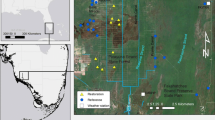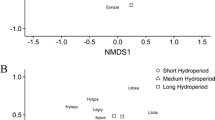Abstract
Amphibian populations have declined worldwide. To pursue conservation efforts adequately, land managers need more information concerning amphibian habitat requirements. To address this need, we examined relationships between anurans and habitat characteristics of wetlands in the Lower Mississippi River Alluvial Valley (LMAV). We surveyed chorusing anurans in 31 wetlands in 2000 and 28 wetlands in 2001, and measured microhabitat variables along the shoreline within the week following each survey. We recorded 12 species of anurans during our study. Species richness was significantly lower in 2000 than 2001 (t-test, P < 0.001) and correlated with an ongoing drought. We found species richness to be significantly greater at lake sites compared to impoundment, swale, and riverine sites (ANOVA, P = 0.002). We used stepwise regression to investigate the wetland types and microhabitat characteristics associated with species richness of chorusing anurans. Microhabitat characteristics associated with species richness included dense herbaceous vegetation and accumulated litter along the shoreline. Individual species showed species-specific habitat associations. The bronze frog, American bullfrog, and northern cricket frog were positively associated with lake sites (Fisher’s Exact Test, P < 0.05), however wetland type did not significantly influence any additional species. Using bivariate correlations, we found that six of the seven most common species had significant associations with microhabitat variables. Overall, our findings support the view that conservation and enhancement of amphibian communities in the LMAV and elsewhere requires a matrix of diverse wetland types and habitat conditions.
Similar content being viewed by others
Literature Cited
Alford, R. A. and S. J. Richards. 1999. Global amphibian declines: a problem in applied ecology. Annual Review of Ecology and Systematics 30: 133–165.
Anderson, A. M., D. A. Haukos, and J. T. Anderson. 1999. Habitat use by anurans emerging and breeding in playa wetlands. Wildlife Society Bulletin 27: 759–769.
Babbitt, K. J. and G. W. Tanner. 2000. Use of temporary wetlands by anurans in a hydrologically modified landscape. Wetlands 20: 313–322.
Beebee, T. J. C. and R. A. Griffiths. 2005. The amphibian decline crisis: a watershed for conservation biology? Biological Conservation 125: 271–285.
Blaustein, A. R., P. D. Hoffman, D. G. Hokit, J. M. Kiesecker, S. C. Walls, and J. B. Hays. 1994. UV repair and dresistance to solar UV-B in amphibian eggs: a link to population declines? Proceedings of the National Academy of Sciences 91: 1791–1795.
Burne, M. R. and C. R. Griffin. 2005. Habitat associations of pool-breeding amphibians in eastern Massachusetts, USA. Wetlands Ecology and Management 13: 247–259.
Cowardin, L. M., V. Carter, F. C. Golet, and E. T. LaRoe. 1992. Classification of Wetlands and Deepwater Habitats of the United States, second edition. U.S. Department of the Interior, Fish and Wildlife Service, Office of Biological Services, Washington, DC, USA.
Dodd, C. K. Jr. and B. S. Cade. 1998. Movement patterns and the conservation of amphibians breeding in small, temporary wetlands. Conservation Biology 12: 331–339.
Dundee, H. A. and D. A. Rossman. 1989. The Amphibians and Reptiles of Louisiana. Louisiana State University Press, Baton Rouge, LA, USA.
Egan, R. S. and P. W. C. Paton. 2004. Within-pond parameters affecting oviposition by wood frogs and spotted salamanders. Wetlands 24: 1–13.
Fredrickson, L. H. and M. K. Laughban. 1994. Managing wetlands for wildlife. p. 623–647, In T. A. Bookhout (ed.) Research and Management Techniques for Wildlife Habitats, fifth edition. The Wildlife Society, Bethesda, MD, USA.
Gardiner, E. S. and J. M. Oliver. 2005. Restoration of bottomland forest in the Lower Mississippi Alluvial Valley, U.S.A. p. 235–252, In J. A. Stanturf and P. Madsen (eds.) Restoration of Temperate and Boreal Forests. CRC Press LLC, Boca Raton, FL, USA.
George, T. L. and S. Zack. 2001. Spatial and Temporal Considerations in Restoring Habitat for Wildlife. Restoration Ecology 9: 272–279.
Gillespie, G. and H. Hines. 1999. Status of temperate riverine frogs in South-eastern Australia. p. 109–130, In A. Campbell (ed.) Declines and Disappearances of Australian frogs. Environment Australia, Canberra, Australia.
Harris, B. 1988. Tetrachoric correlation coefficient. p. 223–225, In S. Kotz and N. L. Johnson (eds.) Encyclopedia of Statistical Sciences, Vol. 9. John Wiley & Sons, New York, NY, USA.
Hazell, D., R. Cunningham, D. Lindenmayer, B. Mackey, and W. Osborne. 2001. Use of farm dams as frog habitat in an Australian agricultural landscape: factors affecting species richness and distribution. Biological Conservation 102: 155–169.
Healey, M., D. Thompson, and A. Robertson. 1997. Amphibian communities associated with billabong habitats on the Murrumbidgee floodplain, Australia. Australian Journal of Ecology 22: 270–278.
Hecnar, S. J. and R. T. M’Closkey. 1996. Regional dynamics and the status of amphibians. Ecology 77: 2091–2097.
Hefner, J. M. and J. D. Brown. 1985. Wetland trends in the southeastern United States. Wetlands 4: 1–11.
James, D. C. and H. Shugart Jr. 1970. A quantitative method of habitat description. Audubon Field Notes 24: 727–736.
Jennings, W. B., D. F. Bradford, and D. F. Johnson. 1992. Dependence of the garter snake Thamnophis elegans on amphibians in the Sierra Nevada of California. Journal of Herpetology 26: 505–508.
King, S. L. and B. D. Keeland. 1999. Evaluation of reforestation in the Lower Mississippi River Alluvial Valley. Restoration Ecology 7: 348–359.
Kotz, S. and N. L. Johnson. 1988. Encyclopedia of Statistical Sciences, Vol. 9. John Wiley & Sons, New York, NY, USA.
Lannoo, M. J. 1998. Amphibian conservation and wetland management in the Upper Midwest: a Catch-22 for the cricket frog? p. 330–339, In M. J. Lannoo (ed.) Status and Conservation of Midwestern Amphibians. University of Iowa Press, Iowa City, IA, USA.
Laubhan, M. K., S. L. King, and L. H. Fredrickson. 2004. Managing wetlands for wildlife. p. 797–838, In C. E. Braun (ed.) Techniques for Wildlife Investigations and Management, 6th ed. The Wildlife Society, Bethesda, MD, USA.
MacDonald, P. O., W. E. Frayer, and J. K. Clauser. 1979. Documentation, Chronology, and Future Projections of Bottomland Hardwood Habitat Loss in the Lower Mississippi Alluvial Plain, volume one. HRB-Singer, State College, PA, USA.
MacKenzie, D. I., J. D. Nichols, J. A. Royle, K. H. Pollock, L. L. Bailey, and J. E. Hines. 2006. Occupancy Estimation and Modeling: Inferring Patterns and Dynamics of Species Occurrence. Academic Press, Boston, MA, USA.
Marsh, D. M. and P. C. Trenham. 2001. Metapopulation dynamics and amphibian conservation. Conservation Biology 15: 40–49.
National Oceanic and Atmospheric Administration (NOAA). 2004a. Billion dollar U.S. Weather Disasters, 1980–2003. US Department of Commerce, NOAA, National Climate Data Center, Asheville, NC, USA. http://www.ncdc.noaa.gov/oa/ reports/billionz.html
National Oceanic and Atmospheric Administration (NOAA). 2004b. Climate at a glance, Mar (Dec–Feb) precipitation Louisiana. US Department of Commerce, NOAA, National Climate Data Center, Asheville, NC, USA. http://climvis.ncdc. noaa.gov/cgi-bin/cag3/hr-display3.pl
National Oceanic and Atmospheric Administration (NOAA). 2004c. Climate at a glance, March 2001 precipitation. U.S, Department of Commerce, NOAA, National Climate Data Center, Asheville, NC, USA. http://climvis.ncdc.noaa.gov/ cgi-bin/cag3/state-map-display.pl
Paton, P. W. and W. B. CrouchIII. 2002. Using the phenology of pond-breeding amphibians to develop conservation strategies. Conservation Biology 16: 194–204.
Pearman, P. B. 1997. Correlates of amphibian diversity in an altered landscape of Amazonian Ecuador. Conservation Biology 11: 1211–1225.
Pechmann, J. H. K., D. E. Scott, J. W. Gibbons, and R. D. Semlitsch. 1989. Influence of wetland hydroperiod on diversity and abundance of metamorphosing juvenile amphibians. Wetlands Ecology and Management 1: 3–11.
Pope, S. E., L. Fahrig, and H. G. Merriam. 2000. Landscape complementation and metapopulation effects on Leopard Frog populations. Ecology 81: 2498–2508.
Ranvestel, A. W., K. R. Lips, C. M. Pringle, M. R. Whiles, and R. J. Bixby. 2004. Neotropical tadpoles influence stream benthos: evidence for the ecological consequences of decline in amphibian populations. Freshwater Biology 49: 274–285.
Rudis, V. A. 1995. Regional forest fragmentation effects on bottomland hardwood community types and resource values. Landscape Ecology 10: 291–307.
SAS Institute. 2001. User’s Guide to the SAS System. Sas Institute Inc., Cary, NC, USA.
Saucier, R. T. 1994. Geomorphology and quaternary geologic history of the Lower Mississippi Valley, volume one. U.S. Army Corps of Engineers, Vicksburg, MS, USA.
Scott, N. J. and B. D. Woodward. 1994. Surveys at breeding sites. p. 118–125, In W. R. Heyer, M. A. Donnelly, R. W. McDiarmid, L. C. Hayek, and M. S. Foster (eds.) Measuring and Monitoring Biological Diversity: Standard Methods for Amphibians. Smithsonian Institution Press, Washington, DC, USA.
Semlitsch, R. D. 1998. Biological delineation of terrestrial buffer zones for pond-breeding salamanders. Conservation Biology 12: 1113–1119.
Semlitsch, R. D. 2000. Principles for management of aquaticbreeding amphibians. Journal of Wildlife Management 64: 615–631.
Semlitsch, R. D. and J. R. Bodie. 2003. Biological criteria for buffer zones around wetlands and riparian habitats for amphibians and reptiles. Conservation Biology 17: 1219–1228.
Smith, M. A. and D. M. Green. 2005. Dispersal and the metapopulation paradigm in amphibian ecology and conservation: are all amphibian populations metapopulations? Ecography 28: 110–128.
Snodgrass, J. W., M. J. Komoroski, A. L. Bryan Jr, and J. Burger. 2000. Relationships among isolated wetland size, hydroperiod, and amphibian species richness: implications for wetland regulations. Conservation Biology 14: 414–419.
Stuart, S. N., J. S. Chanson, N. A. Cox, B. E. Young, A. S. L. Rodrigues, D. L. Fischman, and R. W. Waller. 2004. Status and trends of amphibian declines and extinctions worldwide. Science 306: 1783–1786.
Van Buskirk, J. 2005. Local and landscape influence on amphibian occurrence and abundance. Ecology 86: 1936–1947.
Vitt, L. J., J. P. Caldwell, H. M. Wilbur, and D. C. Smith. 1990. Amphibians as harbingers of decay. Bioscience 40: 418.
Welsh, H. H. and S. Droege. 2001. A case for using plethodontid salamanders for monitoring biodiversity and ecosystem integrity of North American forests. Conservation Biology 15: 558–169.
Wiens, J. A. 1973. Pattern and process in grassland bird communities. Ecological Monographs 43: 237–270.
Wyman, R. L. 1998. Experimental assessment of salamanders as predators of detrital food webs: effects on invertebrates, decomposition and the carbon cycle. Biodiversity and Conservation 7: 641–650.
Zar, J. H. 1999. Biostatistical Analyses. (4th Edition). Prentice-Hall, Engelwood Cliffs, NJ, USA.
Author information
Authors and Affiliations
Corresponding author
Rights and permissions
About this article
Cite this article
Lichtenberg, J.S., King, S.L., Grace, J.B. et al. Habitat associations of chorusing anurans in the Lower Mississippi River Alluvial Valley. Wetlands 26, 736–744 (2006). https://doi.org/10.1672/0277-5212(2006)26[736:HAOCAI]2.0.CO;2
Received:
Revised:
Accepted:
Issue Date:
DOI: https://doi.org/10.1672/0277-5212(2006)26[736:HAOCAI]2.0.CO;2




